The Kanchenjunga Base Camp Trek, one of the most magnificent treks in the world, offers a rare and pristine Himalayan experience that attracts adventure enthusiasts from around the globe. Located in the eastern part of Nepal, this trek takes you to the base camps of Kanchenjunga, the third highest mountain in the world, and is considered a hidden gem in the trekking community. What makes this trek unique is that it offers not one, but two base camp options—the North and the South—both offering different perspectives of this towering, snow-capped giant.
In this article, we explore the Kanchenjunga Base Camp Trek, comparing the two base camps, highlighting their significance, difficulty, and why trekking here should be on every adventure lover’s bucket list.
Why Choose Kanchenjunga Base Camp Trek?
While the Everest Base Camp and Annapurna Base Camp treks are famous among trekkers, the Kanchenjunga Base Camp Trek stands out for its remoteness, rugged beauty, and sense of serenity. Kanchenjunga is a revered mountain, considered sacred by the local people. Its name, meaning “Five Treasures of the Snow,” refers to the five major summits that make up this colossal mountain range. The trek offers unmatched views of towering peaks, deep valleys, and untouched forests, along with a rich cultural immersion in the remote villages of the region.
The trek takes you through a variety of landscapes—from subtropical forests and terraced fields to alpine meadows and glaciers—making it an enriching experience for nature lovers and adventure seekers alike. It is also an excellent choice for those seeking a less crowded alternative to the more famous trekking routes.
The Two Base Camps: North vs. South
The Kanchenjunga Base Camp Trek offers two distinct routes: the South Base Camp and the North Base Camp. Both routes take trekkers through awe-inspiring terrain and provide distinct perspectives of Kanchenjunga, making it a tough decision to choose between the two. Here’s a detailed breakdown of each:
South Base Camp Trek
The South Base Camp Trek is the more popular of the two and is often considered more accessible, making it a favored option for trekkers. The trek begins from the town of Taplejung and gradually ascends through lush rhododendron forests and picturesque villages. As you approach the base camp, the views of Kanchenjunga and its surrounding peaks—like Makalu and Everest—become breathtakingly clear.
- Duration: Approximately 19 to 21 days
- Max Altitude: 5,143 meters (16,873 feet) at Kanchenjunga South Base Camp
- Difficulty: Moderate to challenging
- Highlights:
- Stunning views of Kanchenjunga, Yalung Kang, and Jannu
- Remote villages of the Limbu and Rai communities
- Rich biodiversity and forests filled with rhododendron, oak, and pine
- The sacred Kanchenjunga Glacier
- A rich cultural experience with interactions with locals in isolated settlements
The South Base Camp trek offers an unforgettable experience of the rugged landscapes, a challenging journey with spectacular views, and a chance to immerse yourself in the customs of the indigenous people living in these remote areas.
North Base Camp Trek
The North Base Camp Trek is more difficult, less trekked, and located in a more rugged and remote part of the Kanchenjunga region. The route begins at the town of Taplejung, but instead of heading to the South Base Camp, trekkers head in the opposite direction, traversing more technical terrain. The trek offers amazing views of the Kanchenjunga massif and its northern peaks, as well as glaciers and moraines.
- Duration: Approximately 21 to 24 days
- Max Altitude: 5,143 meters (16,873 feet) at Kanchenjunga North Base Camp
- Difficulty: Challenging to strenuous
- Highlights:
- Spectacular views of the north face of Kanchenjunga
- Remote and less-traveled trail
- Panoramic views of several high peaks like Jannu, Lhotse, and Makalu
- Crossing of the challenging Lhonak Glacier
- Fewer crowds, offering a more peaceful and isolated trekking experience
The North Base Camp trek is ideal for trekkers who are seeking solitude and a greater challenge. This route takes you into the heart of the Kanchenjunga Conservation Area, where you’ll experience pristine wilderness, alpine meadows, and glaciers, while encountering fewer fellow trekkers.
What to Expect on the Trek
The Kanchenjunga Base Camp Trek is not a typical walk in the park; it’s a high-altitude adventure that requires preparation, stamina, and mental resilience. Here’s what you can expect:
1. Stunning Natural Beauty
From dense forests and waterfalls to high mountain landscapes, this trek is a visual feast. You will walk through lush rhododendron forests, cross alpine meadows, and scale rocky ridges, all while being enveloped by views of towering snow-capped peaks.
2. Cultural Encounters
As you trek through the villages, you’ll meet friendly local communities who live in the shadow of Kanchenjunga. The Limbu, Rai, and Sherpa people offer a glimpse into their traditions, culture, and way of life. The trek also offers an opportunity to visit remote monasteries and shrines, where you can witness Buddhist rituals and prayers.
3. Altitude and Weather
The Kanchenjunga Base Camp Trek reaches high altitudes, with the North and South Base Camps both sitting at over 5,000 meters (16,400 feet). The higher you go, the more important it becomes to acclimatize properly to avoid altitude sickness. The weather can be unpredictable, with cold temperatures, especially in the mornings and evenings, and the potential for snow at higher altitudes.
4. Trekking Terrain
The terrain varies from wide, smooth trails in the lower areas to steep and rocky paths at higher elevations. You will also traverse rivers, suspension bridges, and glaciers, requiring a certain level of physical fitness and mental strength.
5. Teahouses and Lodges
Most trekkers will stay in basic teahouses or lodges along the trail. These accommodations are simple but offer warmth, comfort, and a taste of local food, including dal bhat (lentil soup with rice) and momos (dumplings).
When to Trek Kanchenjunga Base Camp
The best times to trek to Kanchenjunga Base Camp are during the pre-monsoon (spring) months of March to May and the post-monsoon (autumn) months of September to November. During these times, the weather is more stable, and the skies are clearer, offering the best views of the mountains.
Permits and Logistics
To trek in the Kanchenjunga region, you’ll need several permits:
- Kanchenjunga Conservation Area Permit
- Restricted Area Permit (for trekking in the region)
- Trekking Information Management System (TIMS) Card
These permits can be arranged through a licensed trekking agency in Nepal.
Conclusion
The Kanchenjunga Base Camp Trek is one of the most rewarding treks in the world. Whether you choose the South or North Base Camp, the trek offers an immersive experience in the remote and beautiful landscapes of the Himalayas. With breathtaking views, diverse ecosystems, and opportunities to learn about the rich culture of the region, this trek promises to be an unforgettable adventure.
For those who crave adventure, solitude, and the chance to experience one of the world’s greatest mountains up close, the Kanchenjunga Base Camp Trek should undoubtedly be on your bucket list. While the trek requires stamina and preparation, the rewards—both in terms of natural beauty and personal achievement—are beyond compare.
Frequently Asked Questions (FAQs)
- How difficult is the Kanchenjunga Base Camp Trek? The trek is challenging due to the high altitude, rough terrain, and long duration. Proper preparation and physical fitness are essential.
- Is the trek suitable for beginners? While it’s not ideal for complete beginners, experienced trekkers with some high-altitude trekking experience can handle the challenge.
- Do I need a guide for the Kanchenjunga Trek? Yes, you need a licensed guide or porter to trek in the Kanchenjunga region due to the restricted area and permit requirements.
- What is the best time to go? The best months are from March to May (spring) and September to November (autumn).
- Can I trek independently? No, independent trekking is not allowed in the Kanchenjunga region. You must trek with a guide and obtain the necessary permits.

